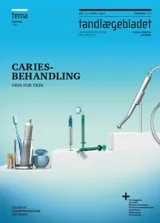Operativ cariesbehandling med fokus på posteriore plastfyldninger
Af miljømæssige grunde er plastmateriale i dag første valg, når fyldninger i permanente kindtænder udføres. Af tandsundhedsmæssige grunde er det derfor interessant at vide, om fyldninger i plast kan leve op til den kliniske funktionstid, der er vist med amalgam. Vigtigt er det også at kende forskelle mellem de to materialers funktion som fyldningsmateriale med henblik på at kunne tilrettelægge og udføre den bedst mulige behandling for patienten. Spørgsmålet er, om de fordele, der er ved plast i form af forbedret æstetik og adhæsive egenskaber, som kan føre til mindre kavitetspræparation og forstærkning af resttandsubstans, kan opveje de ulemper, der er ved plast. Af ulemper kan her specielt nævnes plastens manglende cariesforebyggende egenskaber, dens begrænsede frakturresistens samt den krævende teknik ved fremstilling af en plastfyldning. Langtidskliniske studier har givet ny viden om disse forhold, hvilket vil blive belyst i nærværende oversigtsartikel. Årsager til omlavning af plastfyldninger vil blive diskuteret, og faktorer med indflydelse på fyldningers overlevelse vil blive belyst, herunder hvilke tandtyper og kaviteter der restaureres, forskellige patientrelaterede faktorer, operatørens håndelag og indstilling til, hvornår fyldninger laves om, samt forskellige generelle faktorer. Endelig vil viden om materialernes indflydelse på plastfyldningers overlevelse blive gennemgået, herunder betydning af plasttype, plastens viskositet, bindingsformidler og isoleringsmaterialer.
Operative treatment of caries with focus on resin restorations in posterior teeth
For environmental reasons, composite resin must be the first choice of material for restoration of posterior teeth. For dental health reasons, it is therefore interesting to know, whether longevity of resin restorations can compete with longevity of amalgam restorations. The question is whether the advantages of resin restorations, such as better aesthetics, and better adhesive qualities, leading to reduced cavity preparation and reinforcement of tooth structure, can compensate shortcomings of the material. Important shortcomings are the missing caries preventive effect, the insufficient fracture resistance, and the technique sensitivity. Long term clinical studies have led to new knowledge about these issues, which are highlighted in the present article. Reasons for replacement of resin restorations are discussed, and factors influencing longevity are examined, including type of tooth and cavity sizes, various patient related factors, skills of the operator, and the operator’s indications for replacement of restorations, as well as some general factors. Finally, facts about the various materials’ influence on longevity of the resin restorations are highlighted, including the importance of resin type, resin viscosity, bonding agents, and isolating agents.


